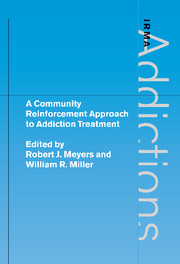Book contents
- Frontmatter
- Contents
- List of contributors
- Preface
- Acknowledgments
- 1 Developing the Community Reinforcement Approach
- 2 Practice and Promise: The Azrin Studies
- 3 The Treatment
- 4 A Comparison of CRA and Traditional Approaches
- 5 Community Reinforcement and Traditional Approaches: Findings of a Controlled Trial
- 6 CRA with the Homeless
- 7 CRA and Treatment of Cocaine and Opioid Dependence
- 8 Community Reinforcement and Family Training (CRAFT)
- 9 Summary and Reflections
- References
- Index
3 - The Treatment
Published online by Cambridge University Press: 05 August 2012
- Frontmatter
- Contents
- List of contributors
- Preface
- Acknowledgments
- 1 Developing the Community Reinforcement Approach
- 2 Practice and Promise: The Azrin Studies
- 3 The Treatment
- 4 A Comparison of CRA and Traditional Approaches
- 5 Community Reinforcement and Traditional Approaches: Findings of a Controlled Trial
- 6 CRA with the Homeless
- 7 CRA and Treatment of Cocaine and Opioid Dependence
- 8 Community Reinforcement and Family Training (CRAFT)
- 9 Summary and Reflections
- References
- Index
Summary
Overview
This chapter outlines the components of the CRA treatment program (see Meyers & Smith, 1995, for complete details). The assessment and treatment planning techniques are utilized with all clients, but a client's particular behavioral deficits dictate which skills training procedures are introduced.
Community Reinforcement Approach functional analyses
Although behavior therapists may already use functional analyses as a standard part of their treatment for various types of disturbed behavior, they are still a relatively rare tool as far as substance-abuse programs are concerned. A traditional functional analysis is a semi-structured interview which outlines the antecedents (triggers) and consequences of a specific behavior. Its purpose is to diagram the context in which the behavior is occurring. Once the triggers for the behavior are identified, we typically assist in the development of a plan either to avoid these high-risk situations, or to acquire the necessary skills for addressing them. As far as examining the consequences of a problem behavior is concerned, this information is critical for determining the role that the behavior is serving. The Community Reinforcement Approach (CRA) functional analysis first looks at the positive consequences, since these are the factors that maintain the behavior. Eventually we work with the client to realize healthier ways to obtain these positive consequences. The negative consequences of the problem behavior are outlined so that the client clearly sees the price that is being paid for the behavior. It also provides us with a list of the people and opportunities that are important to the client and which have been lost or jeopardized because of the problem behavior.
Keywords
- Type
- Chapter
- Information
- Publisher: Cambridge University PressPrint publication year: 2001
- 3
- Cited by



